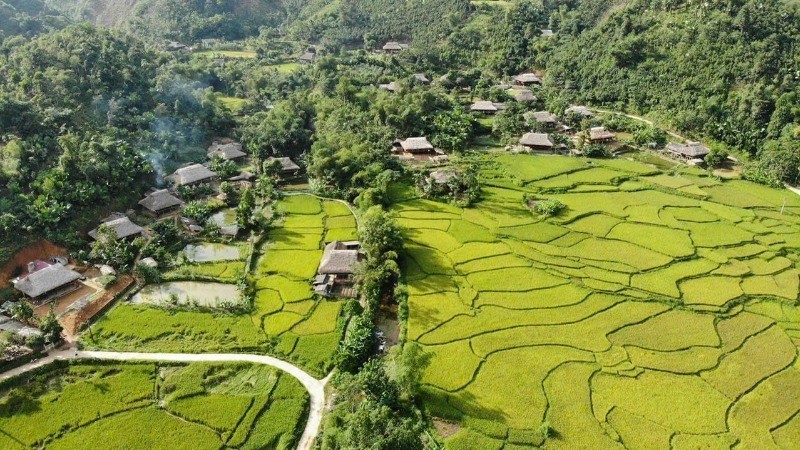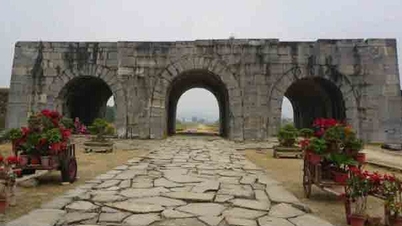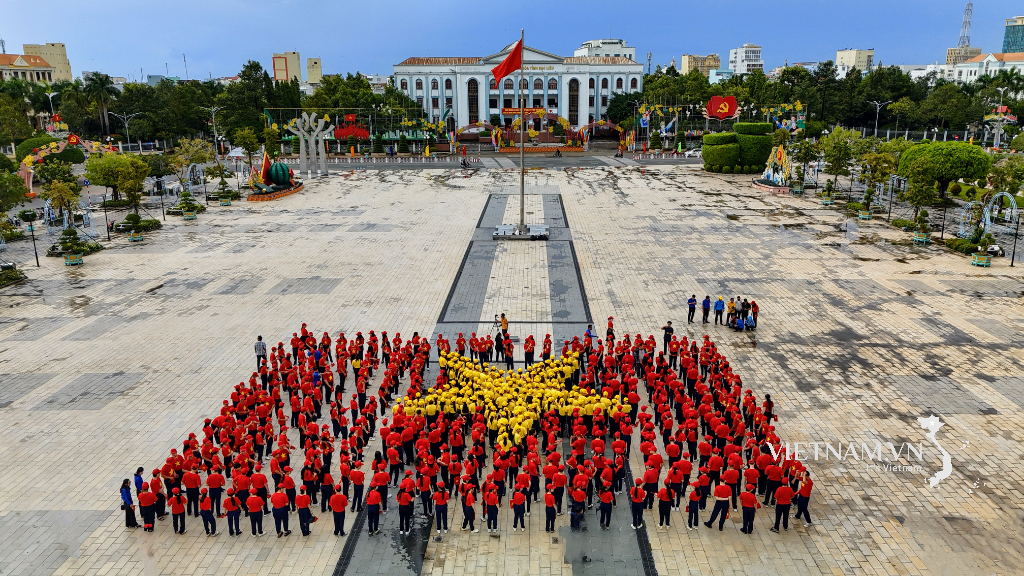In 2024, natural disasters struck, causing heavy losses of life and property. However, shortly afterward, the area burst with new life. Stilt houses were rebuilt, flowers bloomed along the roads, and the laughter of tourists echoed throughout the villages, demonstrating the resilient and tenacious spirit of the Tay people of Nghia Do in the face of countless challenges and hardships.

The picturesque scenery of Nghia Do.
The storm at the end of 2024 caused severe damage to Nghia Do commune: Nearly 400 houses were affected, many completely collapsed, many households were forced to evacuate urgently, and there were tragic casualties. For a land rich in tradition, which had just begun to flourish with community tourism, this was an enormous loss, disrupting many development plans.
Overcoming difficulties to make the village greener.
I remember arriving in Nghia Do in late autumn of 2024, when the mountain mist still hung low, and the villages were still reeling from the devastating flood. The torrential rains and floods carried mud and debris to the hamlets, sweeping away stilt houses, burying fields, and plunging the entire region into sorrow and loss. But amidst the devastation, no one uttered a word of lament. The people of Nghia Do, for generations, have been deeply connected to the land and the forest, suppressing their grief, rebuilding foundations, erecting walls, and repairing roofs...
After the storm, their rough hands resumed weaving baskets, planting flowers, repairing houses, reinforcing dirt roads, and welcoming tourists back. Families who suffered heavy losses also did not forget to keep a few traditional items such as flutes, looms, and rice steamers... to always remember their old homes.
In times of hardship, the people's will becomes even stronger. The village seems to be reborn amidst the green of the palm forests, the flowerbeds along the roadside, and the smiles brimming with faith of the villagers on their journey to restore tourism – to restore the very breath of their homeland.
Ms. Luong Thi Quyen, one of the first people to run a homestay in Ban Hon village, was heartbroken the day before because her house and family heirlooms were destroyed in the mud. However, in the following days, she and her children and grandchildren pulled themselves together to rebuild a new house. Neighbors contributed labor, local organizations provided assistance, and everyone helped in whatever way they could. Although the new house lacks modern amenities, she is determined to maintain traditional customs, spreading out woven mats and setting out meals.
"Tourism isn't just about beautiful houses; the most important thing is the human connection—that's the soul of the village. As long as we can preserve that, we still have a chance to start over," Ms. Quyen shared, her eyes filled with determination and pride for the land she has been attached to.
Following the natural disaster, Nghia Do has been both restoring and upgrading its tourism. More than 30 homestays have been renovated, many ancient stilt houses have been restored according to the traditional architecture of the Tay people, the environment has been improved, roads have been planted with more flowers, streams have been cleaned up, creating a green, clean, beautiful, welcoming, and attractive space for tourists.
The homestays are now more sturdy, although they still preserve the traditional stilt house style. Families have begun collecting more ancient artifacts, reviving folk games, and making souvenirs from brocade and bamboo. The living spaces are thoughtfully arranged so that tourists can not only relax but also fully experience the cultural life of the Tay people.
The village road, once a simple concrete surface, is now lined with flowers, creating vibrant, picturesque pathways. The stream, once blocked by landslides, has been cleared and cleaned by the villagers working together. Bamboo trash bins are placed along the path, each bearing a friendly bilingual reminder: "Keep the village clean – joy in the heart, beauty in the scenery."
Notably, the locals are no longer passively waiting for tourists to come, but are actively learning how to promote their village. Many tourism promotion training sessions are held right at the village cultural center. Most households know how to take photos and videos with their phones and use various digital platforms to introduce their homestays on social media. As a result, less than a year after the natural disaster, Nghia Do not only recovered but also rose to impressive heights.
The number of tourists visiting the commune in the first six months of 2025 increased sharply, nearly 30 times compared to 2020. International tourists are also starting to return, seeking out Nghia Do as a place to "touch" its pristine and authentic identity. Few could have imagined that Nghia Do could rise so strongly from the devastation after the floods. This didn't come from a miracle, but from the hands, minds, and hearts of the people here – people who transformed loss into motivation and hardship into opportunity.
To continue taking the "big step"
Nghia Do has now become a name proudly mentioned on the tourism map of Bao Yen district, Lao Cai province, as a typical model of community tourism linked to cultural preservation. This initial success is the result of a journey of proactive effort and creativity from the local people themselves. What the locality has been and is currently doing goes beyond simply "doing tourism" and has elevated it to "living with tourism".
Homestays serve not only as accommodation for tourists but also as spaces for experiencing the complete culture of the Tay ethnic group. The way the house is decorated, the food, the greetings, the music, and even the sound of weaving in the small kitchen... all create a feeling of intimacy yet sophistication, so that each visitor leaves with a lasting memory.
What is even more valuable is the spirit of not chasing quantity but preserving identity and prestige. The preservation of nearly 1,100 ancient stilt houses demonstrates a long-term vision, refusing to sacrifice identity for modern constructions. Each stilt house is preserved as a "living museum," so that when visitors step inside, they not only see but also feel and understand the spirit and way of thinking of an ethnic group living in harmony with nature.
On a late summer afternoon, Nghia Do was lightly shrouded in mist, the last rays of sunlight slanting across the freshly painted stilt houses. In the cozy homestay of Mrs. Luong Thi Quyen in Ban Hon village, the cheerful laughter of a group of tourists who had just finished their trek through the village echoed around the fireplace. The evening meal was ready: grilled stream fish wrapped in mac khen leaves, steamed free-range pork with lemongrass, boiled wild vegetables with cham cheo dipping sauce, five-colored sticky rice, and a bowl of fragrant corn wine. Mrs. Quyen gently explained the meaning of each dish to the tourists, sharing stories about rice grains and the diligent hands of the farmers.
The atmosphere at the meal was captivating, filled with the delicious food and warm affection, as if after so much loss and suffering, the people still wholeheartedly opened their hearts with what they had: human kindness, culture, sincerity, and profound aspirations. On the wall, a small screen displayed a slideshow of village photos and video clips filmed and edited by family members using smartphones, uploaded to social media to promote local tourism. The younger generation of the Tay people now knows how to livestream the harvest season and festivals in a simple yet emotional way. Amidst the laughter and chatter, the wrinkles on the Tay grandmother's face and the sparkling eyes of the children seemed to hint at a brighter, more stable tomorrow.
Nevertheless, to take further solid strides, Nghia Do needs to continue developing with smart and sophisticated solutions. Nghia Do has been flexible in digital transformation of tourism, but for the people to truly master the technology and turn their distinctive culture into "valuable digital content," solutions that are accessible, easy to understand, highly community-oriented, and closely linked to identity are needed; building a library of copyrighted local content (photos, videos, folk music, etc.) for unified use by tourism households; and synchronizing the booking and promotion system instead of each household having its own page...
According to community tourism experts, localities need to expand tourism models that are linked to hands-on experiences, such as "a day as a Tay person," with activities like weaving, cooking, fishing, and foraging for medicinal herbs in the forest. These small but unique tours will both generate income and help tourists connect deeply with the local culture.
Source: https://baolaocai.vn/nghia-do-suc-song-mien-suoi-sach-dong-xanh-post402317.html





































































































Comment (0)